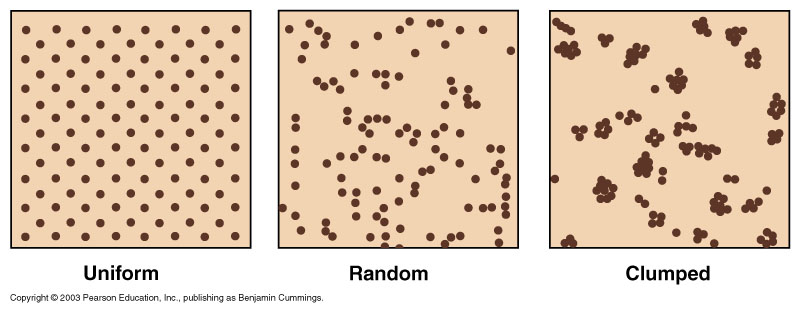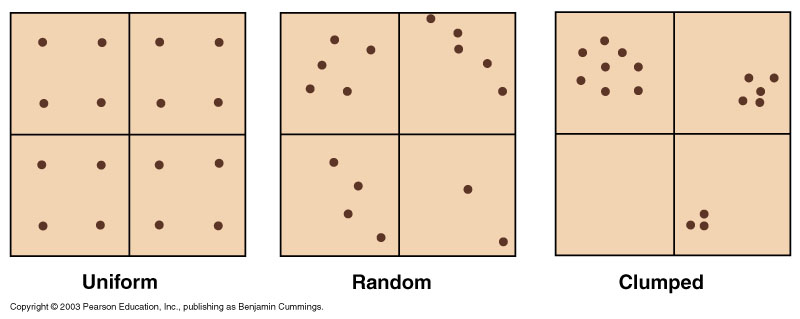
Fundamentals of Ecology Class Meetings
March 2013 (wk.9-10)
Population Ecology - Single Species
Announcements:
Tuesday wk.9 - The Ecology of Single-Species Populations
Outline of Main Topics:
The notes below are also available as a Powerpoint in my O: drive
A) Ecology of Populations
Populations: All the individuals of a species found living within a given area.
Goals of
this subfield of Ecology:
Explain how (& why) populations change through time and space
Basic
Assumption:
Changes in abundance can be explained in terms of the properties of
individuals - & environmental factors affecting them - within populations
Example:
D. Willette & colleagues paper - "...climate & physiology at
population level for... turtles"
- how is this work relevant to both physiological & population ecology?
- what aspects of population ecology are addressed?
- in your groups, discuss these reading questions:
- How might observed climatic impacts affect turtle populations?
- How might pop. impacts differ if the proportion of males to females shifted in the population (as a result of warming climate)?
B) Population Density
Density: Number of individuals of a given species per unit area, or per unit of available/usable habitat.
Distribution - Reflects environmental factors; effects of changing spatial scale:

Dispersion - How organisms are distributed within their habitat; affects measures of density:

Measuring Density: Plants - use of quadrats; but dispersion will influence measurements...:

Measuring Density: Animals -
pretty hard! ...they don't sit still...
Mark-Recapture method (or "Capture-Recapture Sampling" - p 188 in Smith)
C) Population Age Structure
Age Structure of a population has a big impact on how it will change (...or not...) in the future:

What can you predict about the future of each of these populations, in terms of growth, numbers of individuals in each age class, etc.?
What aspects of a species' biology will most influence the age structure of a population?
**birth rates & death rates**
Relate this information to the turtle example - how might Willette's (et al.) observations about turtles & possible changes in sex ratios be expected to affect birth rates? how about death rates? Could this impact the structure of turtle populations in the study?
Life Tables -
Use birth & death rates to construct a systematic picture of
age-specific mortality & survival (...the kind of information life insurance
companies use...)
Life tables can tell us about, e.g., the probability of an organism surviving to the next age class
Used to construct mortality & survivorship curves:


Mortality Curve Survivorship Curve
Questions:
At what ages is mortality highest for grey squirrels?
How long can a grey squirrel be expected to live?
3 Main Forms of Survivorship Curves:

What kinds/groups of organisms might exhibit each shape of curve?
Thursday, wk. 9 & Tues. wk. 10 - The Ecology of Single-Species Populations, cont'd.
ANNOUNCEMENTS:
Outline of Main Topics:
D) Population Growth
Growth - determined by birth rates & death rates (mortality &
survivorship)
change in pop. size
during time interval = Births during time interval - Deaths during
interval
mathematical notation:
N = pop. size
t
= time
D
= change
B
= number of births in time interval
D
= number of deaths in time int.
b = per capita birth rate
(# offspring produced /unit time by ave. pop. member)
d
= per capita death rate
B = bN
r = rate of increase
(per capita growth rate); r = b – d
**tells if pop. = growing (+ r)
or declining (- r) or @ zpg (b = d)
Simplest equation for pop. growth:
DN/Dt
= B-D
Or, substitute per capita growth rate into our equation:
DN/Dt
= rN
or:
dN/dt = rN
(differential eq. form - instantaneous rate of change)
When there are no limits on pop. growth, max r = “intrinsic rate of increase” and we have...
Exponential Growth:
Assumes that resources are unlimited. Realistic??
need to add more complexity to the model -
Limits to growth -
both intrinsic (related to
individuals in population)
& extrinsic (external to individuals in population - environmental factors)
More realistic model:
Logistic Growth (=
Density-dependent):
r is only at maximum when pop. densities low;
pop. growth actually slows as pop. density increases, and approaches K
K =
Carrying Capacity
DN/Dt = rN(K-N/K)
(K-N/K)
this term limits growth
at low levels of N, what will term approach (1 or 0)?
at high levels of N, what will it approach? How
will this affect rate of growth?
Important note r.e. K:
K is not static!!! = imposed by limitations of the
environment, & so can change!

Fluctuations in Population Growth -

Food for Thought:
What might be happening - in terms of population
growth - to the turtle populations described by Willette
& colleagues? Describe in terms of the turtle's biology and also
in terms of one of the population growth models/curves.
Population Dynamics Tutorial - visit this site!
E) Life History Strategies
Survivorship Curves:

Type I Survivorship =
Type III Survivorship =